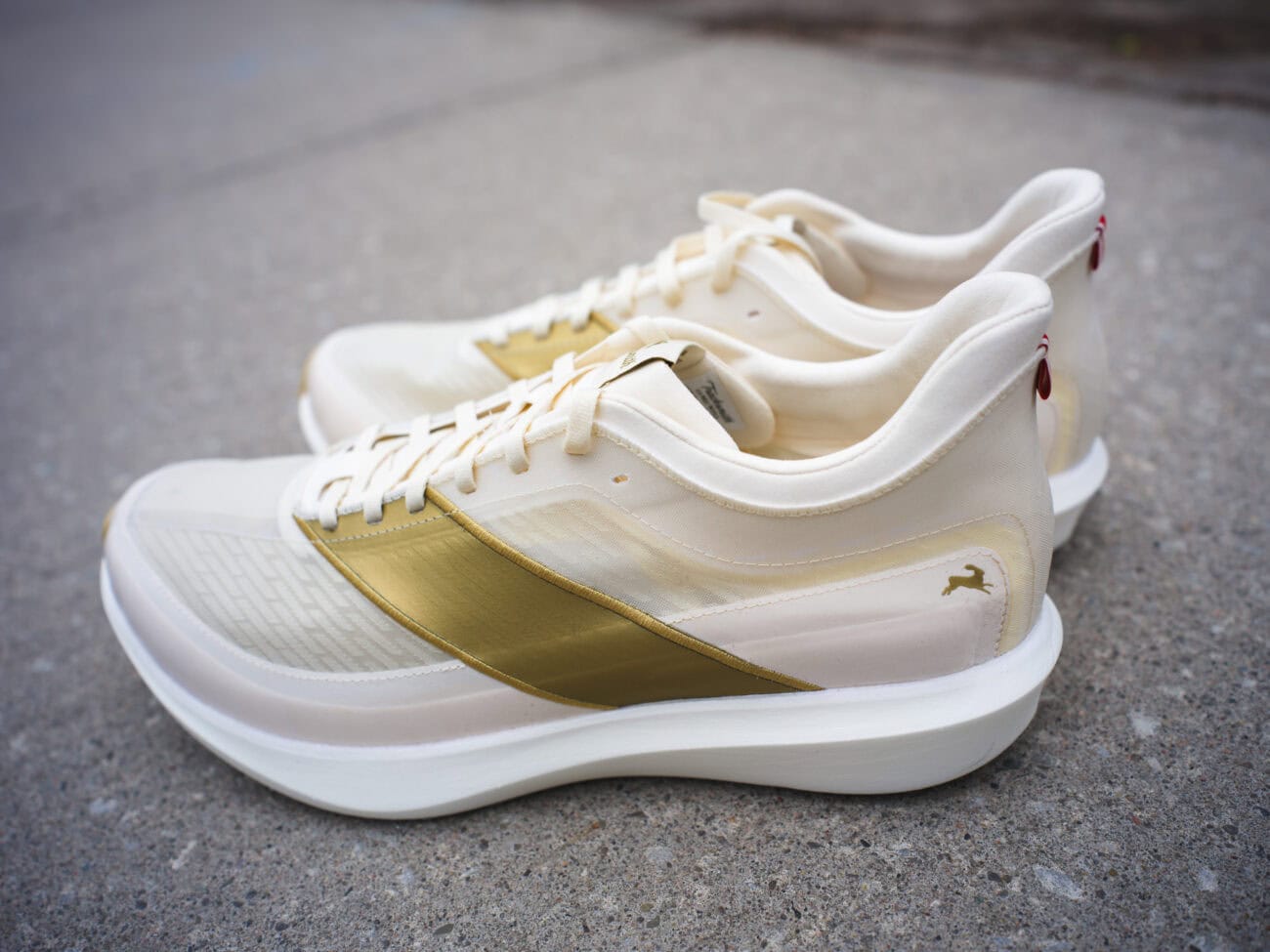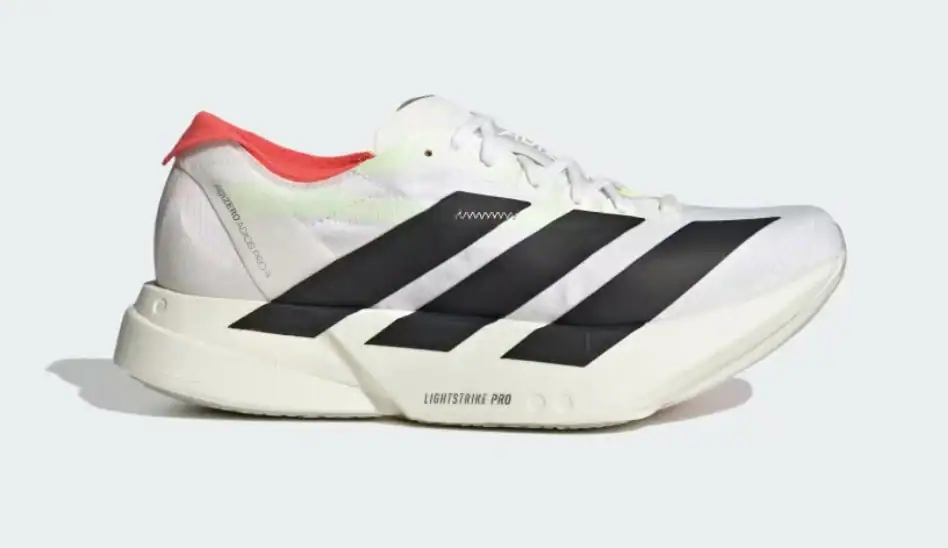I’m about to show you what I think are the five best supershoes that have come out this year. They’re light, they’re flashy, and they’re almost guaranteed to make you faster. So let’s get into it.
We tested a lot of shoes before coming up with a top five. To be featured on this list, and be considered a super shoe, a shoe needed to have three things: a carbon plate, supercritical foam, and some type of rock-forward profile.
That disqualified pretty much any daily training shoe, like the ASICS Nimbus, for example. We made a separate ranking for those – best daily running shoes right now.
The Top Super Shoes On The Market Right Now:
#5 Best for fashion-forward runners: Tracksmith Eliot Racer
#4 Best for shorter races (5K and 10K): Nike Vaporfly 4
#3 Best for cushioning: Saucony Endorphin Elite 2
#2 Best for durability: Adidas Adios Pro 4
#1 Best overall: Puma Fast-R Nitro Elite 3
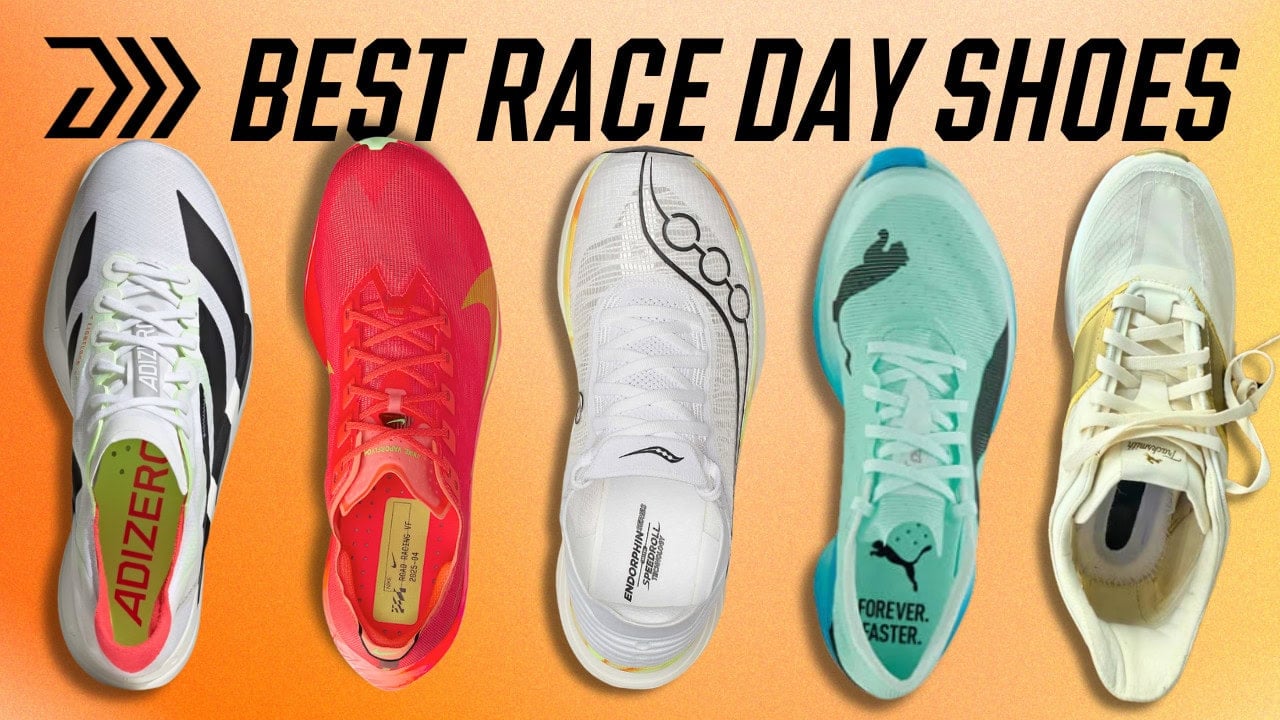
#5 Best Supershoe for fashion-forward runners:
Tracksmith Eliot Racer
Score: 7.6
The Eliot Racer is definitely the most fashionable super shoe on this list—maybe in the world. It’s got a nice muted profile with gold accents around the shoe, including the classic Tracksmith stripes on either side. It even has a running poem carved inside the drop-in midsole. I’ve rarely seen a super shoe this aesthetically pleasing.
Honestly, I didn’t really care about any of that at first. If anything, I was skeptical. For me, the only thing that really matters in a super shoe is speed—and, I guess, comfort. So I was nervous that all those details were just hiding the fact that maybe the shoe didn’t have much bite.
But then I started liking how it felt. It’s got a strong rock-forward profile, keeps you on your midfoot and a bit on your toes, and the foam is PBAX—a very classic foam that brands use in super shoes.
Even though this is technically Tracksmith’s first super shoe, I think they knocked it out of the park. They could still cut some weight, but it’s a really good start, and I’ve been enjoying it for workouts. I haven’t worn it in a race yet—but I could, and I would trust it.
This shoe is good for runners who want to look good while running fast, and maybe for runners who care about sustainability. The midsole is drop-in, meaning you can take it out—and after a while, when the foam loses its bounce, you can replace it for $100 and keep using the body of the shoe. That creates less waste.
But I’d avoid this shoe if you’re trying to save money. For what it is, I think it’s overpriced. It’s not as high-performing as the other shoes I’m going to mention, and yet it’s more expensive than many of them—so I’m not sure it’s the best bang for your buck.
We gave the Eliot Racer a rating of 7.6—a little higher than when we did our standalone review. We bumped the value score up because, back then, we weren’t sure if the drop-in midsole would be replaceable. Now that we know it is, that increases its value in our eyes.
Here’s my dedicated review:
The Deets: Tech Specs For The Tracksmith Eliot Racer
- MSRP: $280 USD
- Release date: January 2025
- Stack height: Heel: 38mm; Forefoot: 30.5mm
- Weight: 7.7oz (218g)
- Heel-to-toe drop: 7.5mm
#4 Best Supershoe for shorter races (5K and 10K):
Nike Vaporfly 4
Score 7.9
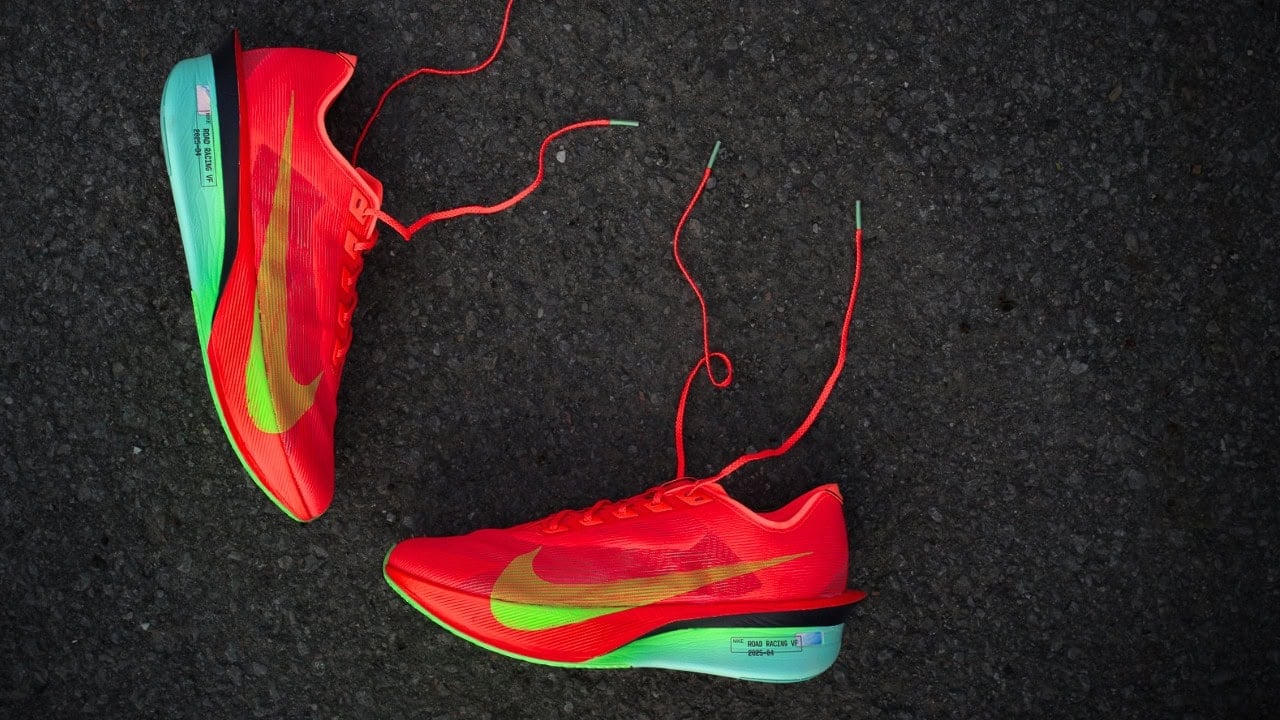
Big pro and big con with the Vaporfly 4.
The pro: it’s super light. At 5.9 ounces, it’s competitive with anything else out there. It’s a funny move by Nike, because the Vaporfly 4 ends up being one of the first super shoes that doesn’t brush against the World Athletics stack height limit of 40mm. Instead of stacking it with foam, Nike went minimal—for a super shoe anyway. The result is a super light running shoe.
The con: you lose a lot of power. The reason most super shoes are so big is because that foam propels you forward. With the Vaporfly 4, Nike sacrificed some of that power for lightness.
So if you expect your shoe to be super bouncy and propulsive—like the Alphafly 3—you’re not going to find it here. That said, the Vaporfly 4 is great for a shorter race, like a 5K or 10K—something that doesn’t require much cushion. I also like it for windy courses. It handles turns better than most super shoes because there’s less bulk, and it feels more stable since it’s closer to the ground.
You might want to look elsewhere if you’re craving a big, cushioned, powerful shoe. If you like Nike, I’d go for the Alphafly instead.
We gave the Vaporfly 4 a rating of 7.9. In our standalone review, it got a lot of points for design—not aesthetics like the Tracksmith Eliot, but the actual construction. I like how Nike created a smaller super shoe. It doesn’t quite have the power yet, but it feels so much more natural on the feet. And my personal theory is that’s where super shoes are going. We won’t have big bulky ones in the future—they’ll be smaller and still powerful.
We did ding it a bit on performance. At the end of the day, if you want something fast, you’re probably going to go with a bigger shoe. There are others with more muscle than the Vaporfly 4.
The Deets: Tech Specs For The Nike Vaporfly 4
- MSRP: $270 USD
- Release date: March 2025
- Stack height: Heel: 35mm; Forefoot: 29mm
- Weight: 6.7oz (190g)
- Heel-to-toe drop: 6mm
#3 Best for cushioning:
Saucony Endorphin Elite 2
Score: 8.0
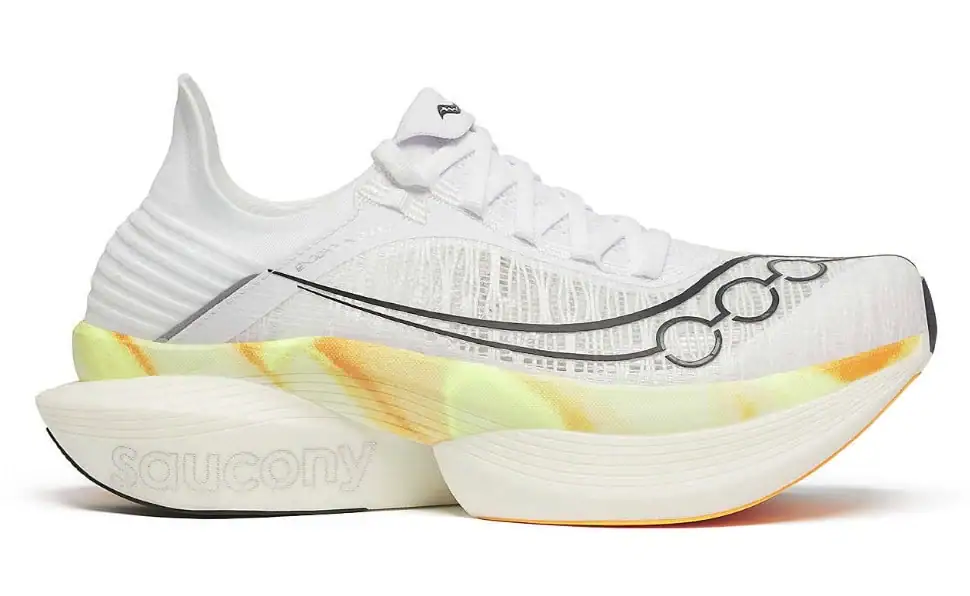
I’ve said this before: the Endorphin Elite 2 is the most underrated speed shoe of 2025. I was blown away by how powerful it is. I didn’t expect Saucony to be behind one of the best shoes this year. Honestly, I felt like they’d been sleeping at the wheel a bit in recent years—especially considering they were one of the first to release a super shoe back in 2020. But the Endorphin Elite 2 makes up for that.
It uses Saucony’s Incredun foam, which is a TPE foam—very light and responsive. They stacked two layers of it for a midsole that’s squishy but powerful. There’s a huge performance difference between this shoe and the two I’ve already mentioned.
I think what throws people off is that not many pros are wearing it—not because it’s bad, but because not many are sponsored by Saucony.
This shoe works well for anything between a 5K and a marathon, though I think it’s best for longer races because of the cushioning.
The one drawback: it’s so squishy and bouncy that it can feel unstable. I’m a pronator, and there’s no stability feature here—so I do feel a bit wobbly. If that’s a concern, you might want to skip it.
We gave the Endorphin Elite 2 a rating of 8.0, boosted by a very high performance score. This thing moves fast.
Here’s my video review and a round-up of the Endorphin series:
The Deets: Tech Specs For The Saucony Endorphin Elite 2
- MSRP: $290 USD
- Release date: March 2025
- Stack height: Heel: 39.5mm; Forefoot: 31.5mm
- Weight: 7.0oz (199g)
- Heel-to-toe drop: 8mm
#2 Best for durability:
Adidas Adios Pro 4
I’ve always been a fan of the Adidas Pro series. I raced in the Pro 2, and now the 4 is a lighter, sleeker version of that. The midsole is TPE foam like Saucony’s, but it’s a bit denser—so it feels more stable.
My favorite feature? Instead of a carbon plate, Adidas uses carbon rods shaped like your metatarsals. That adds some flexibility and reduces weight.
I struggled to rank this above the Endorphin Elite 2—they’re almost equivalent in my mind. But I got a little emotional with the rankings because I’ve raced in this shoe twice and PR’d twice. So I know it’s good.
I’d call the Pro 4 the “Goldilocks” of super shoes: not too big or too small, not too soft or too stiff. It hits a great middle ground and could work for just about anyone.
It’s great for any race—from 5K to marathon—and bonus: it’s durable. The Pro series usually lasts 300–500 km before losing bounce, which is great for your wallet.
We gave it a rating of 8.4, boosted by performance, design, and value. Just a good all-around shoe. If it wasn’t for a wild release that happened in April, this might have been my number one.
Here’s my dedicated video review:
The Deets: Tech Specs For The Adidas Adios Pro 4
- MSRP: $250 USD
- Release date: January 2025
- Stack height: Heel: 39mm; Forefoot: 33mm
- Weight: 6.1oz (200g)
- Heel-to-toe drop: 6mm
One Note Before No. 1…
If you’re a shoe nerd and you’re doing the math, you might notice something missing. There are three big players not yet mentioned—and only one spot left.
I didn’t include the Adidas Adios Pro Evo 2 or the ASICS Metaspeed Sky Paris. They’re both extremely hard to get your hands on, so I disqualified them for now. They’re not available to the public.
Number one, however, is tough to find—but not impossible. And it’s been hiding in plain sight…
#1 Best overall: Puma Fast-R Nitro Elite 3
If you’re curious, check out our standalone review for more detail. But here’s the short version.
This shoe doesn’t introduce groundbreaking tech—but it combines existing ideas better than anything else. It has an ultra-light upper, a seven-layer carbon plate that extends past the toe, and an ATPU foam midsole—lighter and more responsive than PEBAX or even TPE.
So yeah: carbon plate, super foam, rock-forward profile—we’ve seen it all before. Just not in a combination this good.
It feels like a track spike. That’s good and bad. It’s not super cushioned, so if you’re looking for something to save your legs, look elsewhere. Also, it’s not very durable—my outsole is already wearing down after just a few runs.
But it’s by far the fastest shoe I’ve worn. I ran my 10K PR in it. It’s my current racing shoe of choice. The hype is real.
We gave the Fast-R Nitro Elite 3 a rating of 8.6, our highest this year—thanks to performance and design. It just feels like it’s on another level of engineering, with all the cutouts and weight-saving features.
If you don’t mind spending a bit extra—and can find it—this is my top recommendation right now.
Here’s my video review:
The Deets: Tech Specs For The Puma Fast-R Nitro Elite 3
- MSRP: $300 USD
- Release date: April 2025
- Stack height: Heel: 40mm; Forefoot: 32mm
- Weight: 6.0oz (170g)
- Heel-to-toe drop: 8mm


